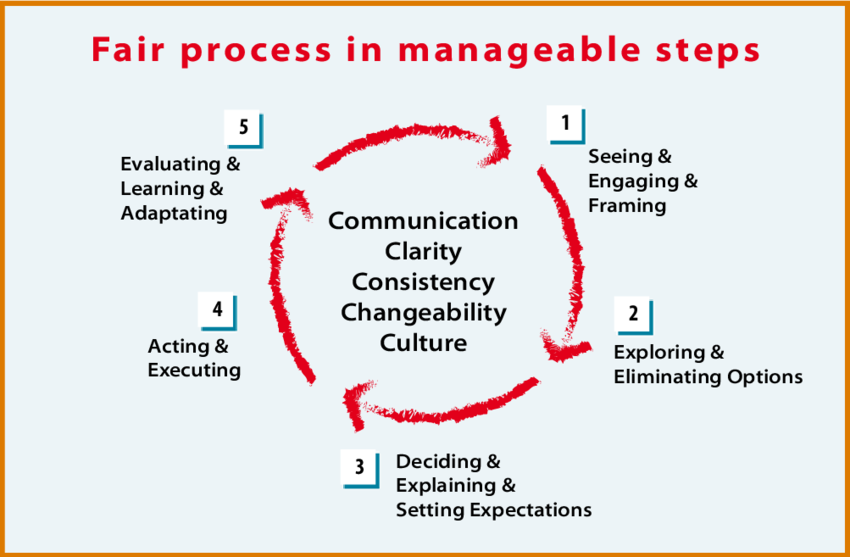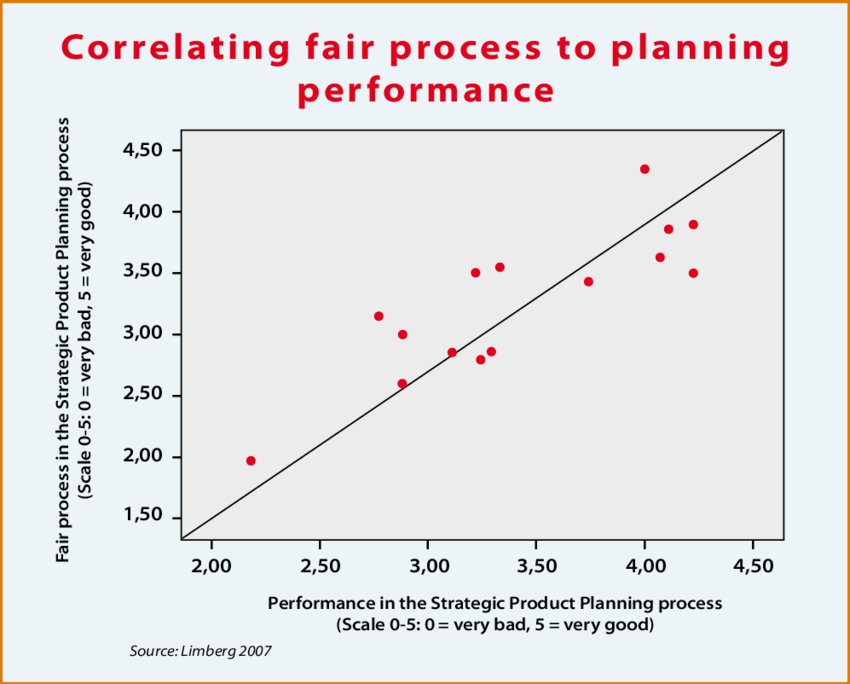Towards a successful collaboration
Fair process
Fair process is a concept developed by W. Chan Kim and Renée Mauborgne in which the execution of the strategy includes creating people’s buy-in up front. When fair process is exercised in the phase of strategy formulation, people trust that a level playing field exists, inspiring voluntary cooperation during the execution phase (Kim and Mauborgne 1991, 1997, 1998, 2003; Woodward and Van der Heyden, 2016).
There are three mutually reinforcing elements that define fair process: engagement, explanation, and clarity of expectation. Whether people are high or low in hierarchy, they all look to these elements (Kim and Mauborgne, 2003).
Engagement
entails involving individuals in the strategic discussions that affect them, by seeking their input and allowing them to express their opinion about the merits of various assumptions and ideas. The result is better strategic decisions by the management, and genuine commitment from everyone involved in execution.
Explanation
entails that everyone involved and affected should understand why specific decisions are made.
Expectation clarity
requires that once the strategy is set, leaders clearly state the new rules of the game. Although the expectations may be demanding, stating them up front provides transparency on how the results will be measured, and what the consequences of the failure would be for the organization and those involved.
Importantly, fair process is not about refuting the authority. Companies are hierarchies and for good reasons: certain members have greater responsibility over final decisions, and therefore are given greater authority and control. Fair process has everything to do with how this authority is exercised – but is not about refuting it. The exercise of fair process typically increases authority, in an implicit way and immediately, as demonstrated in multiple studies that showed a direct correlation between fairness exercised during a process and the overall company performance. Applying fair process is more likely to generate support for a new strategy or a change, and it costs little financially to implement (Van der Heyden et al., 2005; Limberg and Van der Heyden, 2007).


Brockner J. (2006). Why It’s So Hard to Be Fair. Harvard Business Review, March issue
Kim, W. C., & Mauborgne, R. A. (1991). Implementing global strategy: The role of procedural justice. Strategic Management Journal,12,125–143.
Kim, W. C., & Mauborgne, R. A. (1997). Fair process: Managing in the knowledge economy. Harvard Business Review, July–August
Kim, W. C., & Mauborgne, R. A. (1998). Procedural justice, strategic decision making and the knowledge economy. Strategic Management Journal,19,326.
Kim, W. C., & Mauborgne, R. A. (2003). Fair process: Managing in the knowledge economy. Harvard Business Review, January
Van der Heyden, L., Blondel, C., and Carlock, R. (2005) Fair Process: Striving for Justice in Family Business. https://www.researchgate.net/publication/228272173_Fair_Process_Striving_for_Justice_in_Family_Business
Woodward I.C, and Van der Heyden L. (2016) “INVOLVE” – A Toolkit For Fair Process Communication https://knowledge.insead.edu/leadership-organisations/involve-a-toolkit-for-fair-process-communication-4739#Og4C52FSQcmYePbB.99
Limberg, Thomas & Van der Heyden, Ludo. (2007). Why Fairness Matters. International Commerce Review. 7. 92-102. 10.1007/s12146-007-0015-z.
SETTING CLEAR EXPECTATIONS
My approach is intended towards long-term business partnerships with clients. I am committed to performance quality, delivery speed and ongoing support, and will clearly indicate should elements of the mandate be out of scope of my services. Setting clear expectations up front is a prerequisite for the establishment of trust, respect and successful long-term cooperation.
Project Leadership vs. Project Management
A frequent confusion when discussing my expertise with prospective clients is the difference between the Project Manager and Project Leader roles. In my work I focus on supporting my clients from the Project Leadership angle.
At times, these terms are used interchangeably. However, there are critical differences between these roles and each one plays an essential – and complementary – part within a project.
Project Managers are focused on coordinating the project. They are responsible for the tactics that create the end result – a successful project. Their focus is ensuring that the team meets objectives on time and that the project stays within budget.
Project Leaders go beyond the mechanics of managing a project. They are responsible for the overall success and vision for that project. They face a challenge of being strategists, setting a project’s direction, aligning people and motivating the team. People-oriented skills are critical because their goal is to influence the team to accomplish the project’s objectives in a manner that meets or exceeds expectations. Their intervention enables change, innovation and the creation of new products, systems and services.
In successful project teams, close collaboration between Project Leader and Project Manager is essential.
